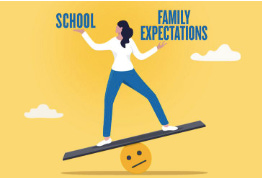Keeping Up When the Ground Keeps Moving: The IEC’s Admissions Challenge
The Changing Admissions Landscape: A Deeper Dive into a Key IEC Pain Point
By Mark Sklarow
A few weeks ago, I shared the five most critical pain points that Independent Educational Consultants experience. (If you missed it, you can find the full blog here: https://marksklarow.substack.com/p/the-hidden-frictions-in-educational.)
As promised, I’m now diving deeper into each, beginning with the one that drew the strongest response: The Changing Admissions Landscape.
For IECs, keeping up with college admissions has become less of a task and more of an impossibility. The terrain is constantly shifting—test policies change, financial aid rules are rewritten, government agencies restructure, and court rulings ripple through campuses. It’s no wonder many of us feel like we’re sprinting just to stay informed.
Let’s unpack why this particular pain point hits such a nerve.
Policy Whiplash: Test-Optional, Affirmative Action, Global Enrollment & FAFSA Chaos
In just a few years, admissions policies have undergone seismic shifts:
The rapid expansion—and more recently, the retreat—of test-optional policies.
The Supreme Court’s decision on the consideration of race in admissions fundamentally altered how students can represent their identities. Just as IECs gained clarity on how colleges were adjusting and when students should reflect on identity in essays, the rules changed again. Now, direct federal actions to dismantle DEI policies, including LGBTQ+ protections, have prompted even threats of Department of Justice oversight of admissions practices.
A surge in international enrollment, from boarding school through grad school, once bolstered institutional finances and diversity. But new visa restrictions and a shift in U.S. political tone have significantly reduced applications from abroad.
FAFSA simplification, intended to make the process easier, instead introduced new confusion and unprecedented delays in aid packaging. Now, further restructuring—including uncertainty about federal aid availability, work-study, and even which agency will oversee aid—has left families (and IECs) in the dark.
For IECs, staying informed isn’t a luxury—it’s a necessity. Families expect us to be in command of these shifting policies. That means daily reading, webinars, cross-checking, and interpreting policy faster than many colleges can update their own websites. Clients look to us to translate headlines into real-world guidance.
So, what’s an exhausted IEC to do?
Create a system for information curation. Subscribe to reliable sources like Inside Higher Ed and The Chronicle of Higher Education. Maintain a searchable archive of key updates. Tap into your professional networks—every IEC knows someone whose finger is on the pulse of financial aid, international admissions, or government restructuring. Follow their posts.
In my view, IECs now must reserve time daily to track and interpret policy updates. It’s also wise to advise families early on:
“Rules and policies are changing so quickly that some things are almost guaranteed to shift between now and when your student matriculates. Let’s agree up front to stay flexible—we may need to adjust course as we go.”
A personal note: I believe this pain point—the need to gather, understand, and apply rapidly evolving policies—is so vital that I’ve devoted a significant portion of my blog writing to exactly this issue. I hope I can continue to be a trusted resource as the landscape continues to evolve.
Family Expectations: A Mix of Memory and Misinformation
Parents often come in with strong—and often outdated—beliefs shaped more by nostalgia, anecdote, or viral TikToks than by facts.
“Little Jimmy comes from a long line of Stanford alums. I know he didn’t stand out in high school, but with our family history, he’s a shoo-in.”
“When I applied, it wasn’t like this.”
“My neighbor’s cousin’s kid got into Yale with a 3.5 and a sailing essay.”
Misinformation isn’t just annoying—it creates emotional friction. IECs spend countless hours gently correcting myths and recalibrating expectations. These conversations are repetitive but essential, and they often determine whether the relationship is trusting or transactional.
So, what’s an exhausted IEC to do?
Use pre-consultation materials and early sessions to bust myths head-on. I admire IECs who use visuals and data—scattergrams, acceptance curves, and historical trend lines—to provide clarity. Nothing shifts a mindset faster than seeing your child’s stats dramatically below a college’s typical admit range. Yes, outliers exist, but basing a strategy on exceptions is risky business.
It also helps to remind families that a well-balanced list is an IEC’s most important deliverable. A 1240 SAT and a B+ average may have led to a UPenn acceptance in 1985—but that tells us nothing about 2025.
Fit vs. Prestige: A Delicate Reframe
Every IEC knows this moment: A student is beaming about a perfect-fit college—until a parent interrupts:
“But won’t a school like that hurt her chances for grad school? Don’t you think she should apply to at least one Ivy?”
Reframing success around fit rather than brand-name prestige is noble and necessary—but also emotionally taxing. It takes time, trust, and empathy to help families see that happiness, growth, and long-term success are more important than a bumper sticker on the car.
So what’s the strategy?
Don’t fight prestige—redefine it.
Talk about prestige in the context of programs:
“Looking for prestige in engineering? Here’s where it lives. In design? Let’s look here.”
Remind families that graduate schools routinely admit studentswho stand out while attending lesser-known liberal arts colleges, honors programs at state schools, and non-Ivies with stellar faculty mentorship.
And remember: there's no need to talk families out of applying to highly selective colleges. But you do want to set expectations early and often, and center the conversation on success and thriving—because that can happen almost anywhere.
Mark’s Bottom Line
This pain point isn’t going away—it’s intensifying. But it’s also what makes this work so meaningful.
IECs aren’t just keeping up with change.
We’re helping families navigate it.
With clarity, care, and courage.




What a tremendous contribution to your community!
I have been writing a newsletter for my school to keep in the habit of reading about the continuous changes so that I can stay on top of them and ensure that our families do as well. Now that I have retired I plan to keep doing so, both for my own edification and for my clients.